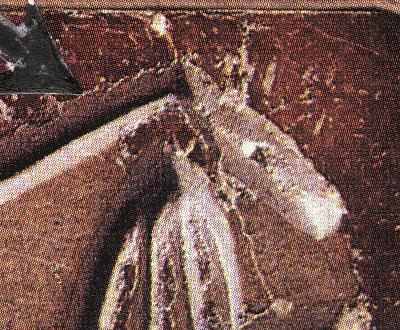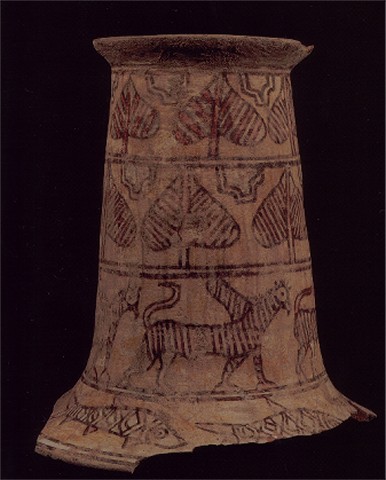Vedic-Harappan Gallery
Presented by
N.S. Rajaram
This poster shows some of the commonly occurring symbols at Harappan sites and artifacts and show their connections to the Vedic literature, thereby proving that Vedic and Harappan civilizations were one and the same.
Background
Going back more than a hundred years, history books have claimed that the Vedic Civilization of India began with an 'Aryan Invasion' from Eurasia, which took place near 1500 BC. When the cities of the Harappan Civilization (or the Indus Valley Civilization) were discovered, scholars claimed that they were part of a pre-Vedic civilization destroyed by the invading Aryans. This continues to be the position of many Indologists, especially in the West. This means that the Harappan Civilization was totally unrelated to the Vedic.
A careful examination of Harappan sites and artifacts shows this to be totally unfounded. It shows that the Harappan Civilization carries the Vedic imprint at every stage. In particular, it shows that Harappan artifacts are steeped in Vedic symbolism. This means that the Harappan Civilization was Vedic, and there was no break due to any invasion.
The rest of this page demonstrates this basic fact — Vedic-Harappan — unity by examining a few well-known Harappan symbols and their relationship to the Vedic literature.
Harappan Yoga
There is evidence to show that the Harappans practiced Yoga. Given below are several clay figurines from sites like Harappa, Mohenjo-Daro and others showing various Yogic postures. Yoga is essentially Vedic.
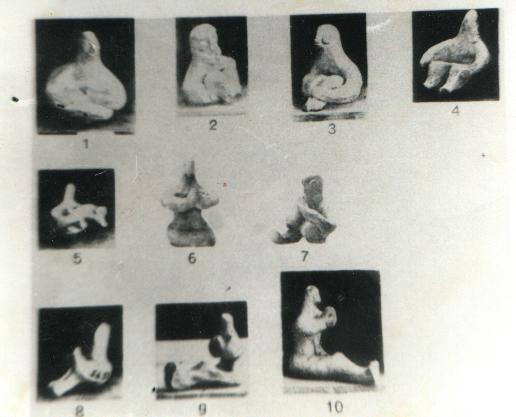
Swastika
To see further this Vedic-Harappan connection , one can begin with familiar sacred symbols like the swastika signs.

Harappan sites are replete with the swastika. Swastika stands for svasti-ka, meaning ‘maker of welfare’. They appear singly as well as in combination with other signs. The figure above shows a string of five swastikas. This is related to the sacred panca-svasti mantra found in the Yajurveda (25.18 – 19), in which the word ‘svasti’ (welfare) appears five times. It may be paraphrased as:
We invoke him who may bring us welfare.
May the
respected Indra guard our welfare,
May the
omniscient Pushan guard our welfare,
May the
Universal Creator guard our welfare,
May the
Great Protector bring us welfare.
This is an example of the deep connections between Harappan archaeology and the Vedic literature.
OM Sign
Such connections are not limited to the Rigveda and the Yajurveda; they span the whole gamut of Vedic literature, including the Brahmanas, Upanishads and others. This can be understood by looking at the OM sign, known also as pranavakshara. The seal below is known as 'onkara mudra' or the OM seal.
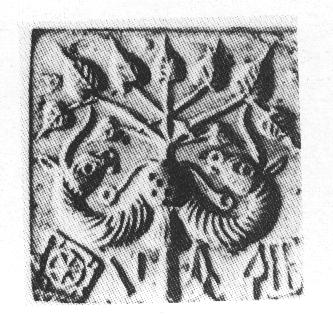
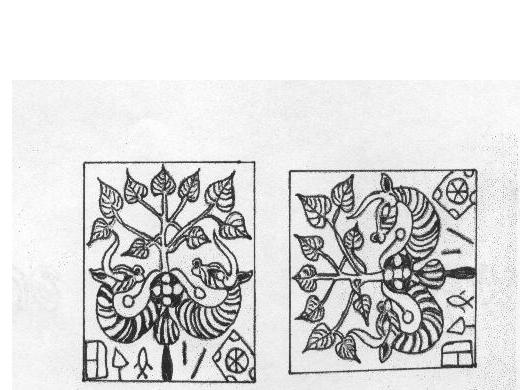
The figure above displays line drawings of the same seal in two positions— original and rotated by 90 degrees. The one on the right — i.e. rotated by 90 degrees — is practically the Devanagari ‘om’. Other scripts like Kannada and Telugu have retained the original orientation of the Harappan ‘om’, while elongating it a little. All of them derive from the Harappan ‘Om’ and have deep connections with Vedic thought as described below.
This ‘bow-shaped’ Harappan ‘Om’ is described in several places in the Vedic literature. The Mundaka Upanishad (2.2.4) describes it as: “Pranava (Om) is the bow, the soul is the arrow, Brahma is the target. With full concentration, aim at the target and strike, to become one with Brahma, just as the arrow becomes one with the target.”
The OM is intimately linked to the asvattha (pipul) leaf, which is another sacred symbol in Vedic thought and even today. Here are more examples from the Vedic literature.
The Katha Upanishad (2.3.1) contains almost a visual description of the Om as an ashvattha (pipul) tree growing downward: “This is the eternal ashvattha tree, with the root at the top (urdhvamoolo), but branches downwards. It is He that is called the Shining One and Immortal. All the worlds are established in Him, none transcends Him.” The same idea is echoed in the Bhagavadgita (15.1): “He who knows that ashvattha tree with its root above and branches down, whose leaves are the Vedas said to be imperishable. And he who knows it knows the Vedas.”
In all this there is the symbolism of the ashvattha as the seat of
sacred knowledge (or Veda), and the abode of the Gods. This idea goes back to
the Rigveda itself (X.97.5): “Your abode is the ashvattha tree,
your dwelling is made of its leaves.” With such explicit Vedic symbolism,
there cannot be the slightest doubt that Harappan archaeology contains physical
representations of Vedic ideas. What is described is but a miniscule sample of
the Vedic symbolism that pervades Harappan archaeology.
Harappan
horse: an irrelevant issue
The horse and the cow are mentioned often in the Rigveda, though they generally carry symbolic rather than physical meaning. There is a widespread misconception that the absence of the horse at Harappan sites shows that horses were unknown in India until the invading (or migrating) Aryans brought them. ‘No horse at Harappa’ has assumed almost the status of a sacred dogma for the upholders of the foreign origin of the Vedas. This is unfounded, for such ‘argument by absence’ is hazardous at best. To take an example, the bull is quite common on the seals, but the cow is never represented. We cannot from this conclude that the Harappans raised bulls but were ignorant of the cow.
Given below are images from two seals-- one containing the horse, and the other the head of a horse. A horse figurine from Lothal is also given.
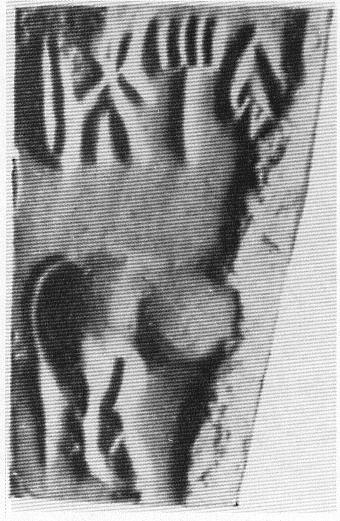

These pictures make it clear that horses were known to the Harappans. This is not limited to artists' depictions, which may be open to debate. The just released and authoritative work The Dawn of Indian Civilization, Volume 1, Part 1 observes (pages 344 – 5): “… the horse was widely domesticated and used in India during the third millennium BC over most of the area covered by the Indus-Sarasvati [or Harappan] Civilization. Archaeologically this is most significant since the evidence is widespread and not isolated.”
Actually, the Harappans not only knew the horse, the whole issue is irrelevant. To prove their point, scholars who insist on the non-Indian origin of the Vedas must produce positive evidence: they must show that the horse described in the Rigveda was brought from Central Asia. But this is contradicted by the Rigveda itself. In verse I.162.18, the Rigveda describes the horse as having 34 ribs, while the Central Asian horse has 18 pairs (36) of ribs. We find a similar description in the Yajurveda also. This means that the horse described in the Vedas is the native Indian breed and not the Central Asian. The 34-ribbed horse has been known in India going back tens of thousands of years. This makes the whole argument based on ‘No horse at Harappa’ not only false, but also irrelevant.
Even this misses the symbolic significance of the horse. Composite animals that include the horse are described in the Rigveda. For example the Rigvedic verse I.163.1 describes a mythical horse as: “possessed with wings of a falcon and the limbs of a deer.” The figure below displays a vase found at Mehrgarh— a pre-Harappan site — with a picture of this composite animal. Notice also the ashvattha leaves, also linking it to Vedic thought. It is a very ancient artifact from the pre-Harappan site of Mehrgarh. So parts of the Rigveda must be at least that ancient, not brought into India by any ‘Aryan invaders’ in 1500 BC. Here is the vase with the image along with the ashvattha leaves, which again shows the Vedic connection.
In summary, the Vedic and Harappan civilizations were one. Harappan artifacts are material representations of ideas and thoughts found in the Vedic literature. The Harappans therefore were Vedic Harappans.
_______________
The
author, Dr.
N.S. Rajaram is a mathematician and linguist who has written extensively on
ancient India. He is the author (with David Frawley) of Vedic Aryans and the
Origins of Civilization and The Deciphered Indus Script (with N. Jha).
He is currently working with Jha on the book Vedic Symbolism in Indus Seals.
